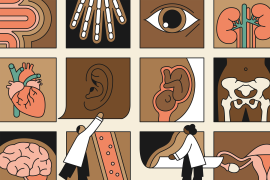By John Reichard, CQ HealthBeat Editor
November 8, 2007 -- A key federal advisory panel debated strategies Thursday to boost enrollment in programs that pick up Medicare's out-of-pocket costs, including having Social Security offices enroll eligible seniors in "Medicare Savings Programs," which pick up some or all of Medicare's premiums and that may pay its deductibles and co-insurance costs.
Medicare guarantees universal coverage of the elderly, but even so, many seniors go without needed care because they don't have enough money to pay costs not picked up by the program. And to the extent they qualify for government programs that pick up some or almost all of those costs, only a low percentage of those eligible are actually enrolled.
A package of draft recommendations debated by the Medicare Payment Advisory Commission (MedPAC) also seeks to heighten awareness of Medicare's prescription drug benefit for low-income elderly or disabled Americans. Almost half of Medicare beneficiaries eligible are unaware of the benefit, which in many cases covers almost all of their prescription drug costs.
MedPAC staffer Joan Sokolovsky and Hannah Neprash laid out some of the problems low-income seniors face in a presentation to the commission Thursday. Medicare beneficiaries as a whole typically have higher out-of-pocket health costs than the rest of the population, but incomes are lower, they noted. While the median income of American adults under age 65 was $28,077 in 2006, it was $17,045 for those 65 or older. And almost two-thirds of those 65 or older had incomes below $19,000 a year, they said, citing U.S. Census data.
"High out-of-pocket health care costs may motivate Medicare beneficiaries, especially those near the poverty line, to avoid necessary health care," the staffers said. "Overall self-reported rates of avoidance among low-income seniors were 30.9 percent for physician visits, 20.7 percent for hospital visits, and 26 percent for prescription filling," they added.
Medicare Savings Programs lower those out of pocket costs. "MSPs" consist of three different types of programs. The Qualified Medicare Beneficiary (QMB) program is for those with incomes below the federal poverty line and covers Medicare Part A premiums and Part B premiums and other cost-sharing expenses such as deductibles, copayments, and coinsurance. The Specified Low-Income Medicare Beneficiary (SLMB) is for those with incomes between 100 and 120 percent of the poverty line and pays for Part B premiums only. The Qualifying Individual (QI) program is for those with incomes between 120 and 135 percent of the poverty line and also pays Part B premiums.
"MSP enrollment reduces health care avoidance," according to the staffers. For example, "QMB enrollees were half as likely as non-enrollees to report physician avoidance," they said.
But lack of awareness of the programs, complexity of the applications and enrollment processes, and the reluctance to go to state Medicaid offices to sign up because of perceived welfare stigma all hinder participation, according to the analysts. Only about one-third of those eligible for the QMB program are actually enrolled, and the figure is lower for the SLMB program, Sokolovsky said. A number of factors complicate outreach; for example, many of those eligible but unenrolled live in rural areas, have cognitive difficulties, or are homebound.
However, foundation grants funding targeted outreach programs have paid dividends. "Successful efforts targeted individuals and provided specific information on how and where to get help with enrollment," the staffers said. Minnesota's State Health Insurance Assistance Program (SHIP) used grant money to sharply boost MSP enrollment on Indian reservations, Sokolovsky said.
However, these "SHIP" programs get limited federal money. Under one of the draft recommendations, the Secretary of Health and Human Services would be required to increase SHIP funding, which also aids efforts to find and enroll those eligible for Medicare's low-income drug benefit. "The SHIPs should use the additional money to support work to increase participation in programs targeted to low-income beneficiaries," the draft language says. Added money could be used to train local volunteers to provide counseling on program eligibility, buy laptops to submit applications from homes, churches, and other community sites, provide more rural outreach, and provide written materials and translators for non-English speakers, the staffers said.
MedPAC will vote on the recommendation at its meeting in December.
It also will consider a recommendation to simplify the application process for MSPs by making income eligibility and asset requirements consistent with that for the low-income drug benefit. The latter benefit allows those with slightly higher incomes and larger amounts of assets to qualify. A third recommendation to be considered next month states that Congress "should change program requirements so that the Social Security Administration screens Low Income Subsidy applicants for federal MSP eligibility and enrollees them if they qualify." LIS refers to the subsidy for the low-income prescription drug benefit.
Commissioners voiced support for all three recommendations but noted that having Social Security offices enroll LIS applicants in the MSPs if they qualify would in effect lead to greater state spending because MSPs are funded by state Medicaid programs. Commissioner Nicholas Wolter questioned whether it was appropriate for the Medicare commission to make recommendations affecting state Medicaid spending. He expressed hope that the panel would find a way to move forward on the recommendations, however, saying they were "spot on" in terms of what is good policy for low-income beneficiaries.


